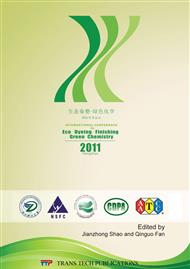p.522
p.526
p.531
p.536
p.540
p.544
p.549
p.555
p.559
The Impact of Textile Wet Colouration on the Environment in 2011
Abstract:
Wet textile colouration has the highest environmental impact of all textile processing steps. It consumes water, chemicals and energy and produces liquid, heat and gas waste streams. Liquid effluent streams are often quite toxic to the environment. There are a number of different dyeing processes, normally fibre type specific, and each has a different impact on the environment. This research investigated the energy, chemical and water requirements for the exhaust colouration of cotton, wool, polyester and nylon. The research investigated the liquid waste biological oxygen demand, total organic carbon dissolved solids, suspended solids, pH and colour along with the energy required for drying after colouration. Polyester fibres had the lowest impact on the environment with low water and energy consumption in dyeing, good dye bath exhaustion, the lowest dissolved solids levels in waste water, relatively neutral pH effluent and low energy in drying. The wool and nylon had similar dyebath requirements and outputs however the nylon could be dyed at far lower liquor ratios and hence provided better energy and water use figures. Cotton performed badly in all of the measured parameters.
Info:
Periodical:
Pages:
540-543
Citation:
Online since:
January 2012
Authors:
Keywords:
Price:
Сopyright:
© 2012 Trans Tech Publications Ltd. All Rights Reserved
Share:
Citation:


